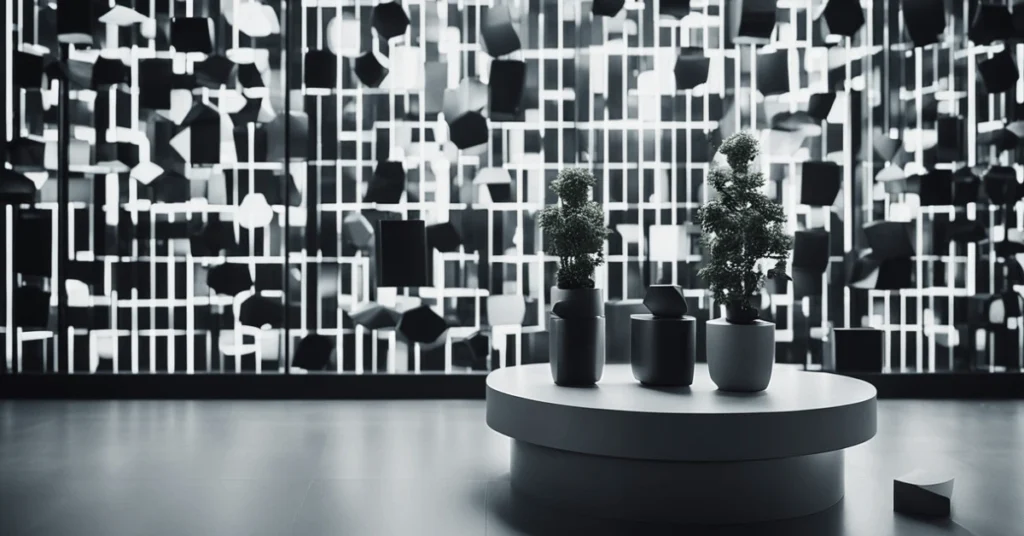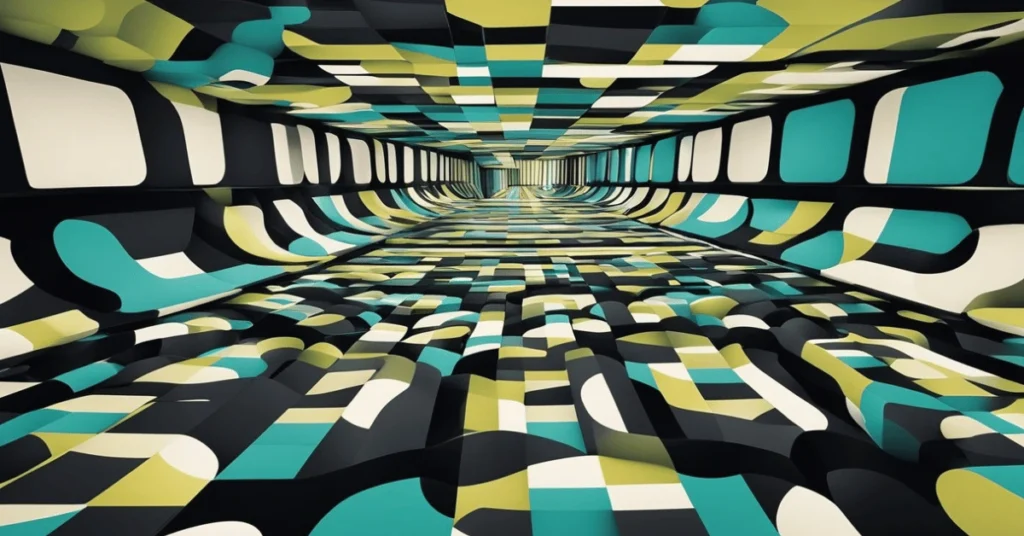In the realm of minimalist artwork, less truly is more. This art form, celebrated for its understated beauty and geometric precision, offers a serene escape from the chaos of modern life.
In this guide, we’ll unravel the essence of minimalist artwork, tracing its roots, key figures, and the profound influence it has had across various creative fields.
Whether you’re an art enthusiast or a curious observer, our journey through the world of minimalist art promises to enrich your understanding of this elegant and impactful style. Join us as we explore how simplicity in art can speak volumes.
Key Insights on ‘Minimalist Artwork’
- Simplicity Redefined: Explore the transformative journey of minimalist art from its origins to modern influences.
- Influential Artists: Discover key figures who pioneered minimalist art, shaping its distinct style and philosophy.
- Artistic Elements: Understand the core characteristics of minimalist artwork, emphasizing geometric forms and monochrome palettes.
- Cross-disciplinary Impact: Learn about minimalist art’s profound influence across architecture, interior design, music, and fashion.
- Enduring Legacy: Reflect on the ongoing relevance and legacy of minimalist art in contemporary culture.
Origins of Minimalist Art
Minimalist art emerged in the 1960s as a reaction against the dominant Abstract Expressionism movement. This new art form was characterized by its simplicity, use of geometric shapes, and lack of ornamentation. Minimalist artists sought to reduce art to its most essential elements, stripping away all extraneous details.
The origins of minimalist art can be traced back to the work of Kazimir Malevich, a Russian painter who founded the Suprematism movement in the early 20th century. Malevich’s work was characterized by its use of geometric shapes and bold, primary colors.
In the 1920s, the De Stijl movement emerged in the Netherlands, which also emphasized the use of geometric shapes and primary colors. The movement had a significant influence on minimalist art, particularly in its use of the grid as a compositional device.
Minimalist art as we know it today began to take shape in the United States in the 1960s. Artists such as Donald Judd, Dan Flavin, and Carl Andre were among the pioneers of this new art form. They rejected the emotionalism of Abstract Expressionism and sought to create art that was objective and impersonal.
Minimalism quickly became a major art movement, with New York City as its epicenter. The movement was characterized by its use of industrial materials, such as steel and aluminum, and its emphasis on the physical presence of the artwork itself.
Key Figures in Minimalist Art

When discussing minimalist art, there are several key figures that come to mind. These artists were instrumental in shaping the movement and creating some of the most iconic minimalist artworks of all time. Here are some of the most notable figures in minimalist art:
- Sol LeWitt: Known for his use of geometric shapes and lines, LeWitt’s artwork often involved simple, repetitive forms. He is perhaps best known for his wall drawings, which were large-scale works that covered entire walls with intricate patterns and shapes.
- Frank Stella: Stella’s minimalist artwork was characterized by its use of bold, geometric forms and bright colors. He often used industrial materials like aluminum and steel to create his sculptures, which were typically large in scale.
- Donald Judd: Judd’s minimalist artwork was focused on the use of simple, geometric forms and industrial materials like steel and Plexiglas. His sculptures were often arranged in large, open spaces, allowing viewers to experience the work in a unique way.
- Robert Morris: Morris was known for his use of unconventional materials like felt and fiberglass in his minimalist artwork. He often created large-scale sculptures that were meant to be experienced in a specific environment, such as a gallery or museum.
- Dan Flavin: Flavin’s artwork was focused on the use of fluorescent light. He often used these lights to create large-scale installations that transformed the space they were in.
- Agnes Martin: Martin’s work was characterized by its use of subtle colors and simple, repetitive forms. She often used a grid pattern in her paintings, which gave them a sense of order and structure.
- Carl Andre: Andre focused on the use of industrial materials like steel and bricks. He often arranged these materials in simple, geometric patterns, creating sculptures that were both beautiful and functional.
- Ellsworth Kelly: Kelly’s work stands for bold, flat colors and simple, geometric forms. He often used these forms to create large-scale paintings and sculptures that were meant to be experienced in a specific environment.
- Richard Serra: Serra focused on the use of large, industrial materials like steel and concrete. He often created sculptures that were meant to be experienced in a specific environment, such as a museum or public space.
- Eva Hesse: Hesse’s minimalist artwork was characterized by its use of unconventional materials like latex and fiberglass. She often created sculptures that were both beautiful and unsettling, challenging viewers to question their perceptions of art and beauty.
These key figures in minimalist art helped to shape the movement and create some of the most iconic artworks of the 20th century. Their work continues to inspire artists and art lovers around the world today.
Characteristics of Minimalist Artwork

Minimalist artwork is a form of abstract art that emerged in the mid-20th century. It is characterized by its simplicity, reductionist approach, and focus on essential elements. Here are some of the key characteristics of minimalist artwork:
- Simplicity: Minimalist artwork is often characterized by its simplicity. It is stripped down to its essential elements, with no unnecessary ornamentation or decoration.
- Geometric forms: Minimalist artwork often features geometric forms, such as squares and rectangles. These forms are often repeated or arranged in a grid-like pattern.
- Monochrome: Minimalist artwork often uses a limited color palette, with a focus on monochrome or neutral colors such as black, white, and gray.
- Clean lines: Minimalist artwork often features clean, smooth lines. These lines are often precise and carefully executed.
- Reductionist approach: Minimalist artwork is often characterized by its reductionist approach. It seeks to strip away all non-essential elements, leaving only the most basic forms and shapes.
- Focus on materiality: Minimalist artwork often emphasizes the materiality of the art object. It may use industrial materials such as steel or concrete, or it may use natural materials such as wood or stone.
- Personal expression: Despite its focus on simplicity and reduction, minimalist artwork can still be a form of personal expression. It allows artists to explore their own relationship to form, material, and space.
Influence of Minimalist Art in Other Fields

Minimalist art has had a significant impact on various fields beyond visual art. Its emphasis on simplicity, repetition, and reduction has inspired many artists and designers in different disciplines. In this section, we will explore some of the ways in which minimalist art has influenced other fields.
Architecture
Minimalist art has greatly influenced modern architecture. Architects such as Ludwig Mies van der Rohe and Le Corbusier were inspired by the minimalist movement and incorporated its principles into their designs. Minimalist architecture emphasizes clean lines, simple forms, and a focus on function over ornamentation.
Interior Design
Minimalism has also had a significant impact on interior design. Minimalist interiors are characterized by their simplicity, clean lines, and lack of clutter. The use of natural materials such as wood, stone, and metal is also common in minimalist interiors.
Music
Minimalist music is a subgenre of contemporary classical music that emerged in the 1960s. Composers such as Steve Reich, Philip Glass, and Terry Riley were influenced by minimalist art and its emphasis on repetition and reduction. Minimalist music is characterized by its repetitive patterns and use of simple harmonic structures.
Fashion
Minimalist art has also influenced the fashion industry. Minimalist fashion emphasizes simplicity, clean lines, and a focus on quality over quantity. The use of neutral colors such as black, white, and gray is also common in minimalist fashion.
Land Art
Minimalist art has had a significant impact on land art. Land artists such as Robert Smithson and Michael Heizer were inspired by the minimalist movement and incorporated its principles into their work. Land art emphasizes the use of natural materials and a focus on the landscape itself.
Mirrored Cubes
Mirrored cubes are a common element in minimalist art. They are often used to create optical illusions and to reflect the surrounding environment. Mirrored cubes have also been used in architecture and interior design to create a sense of space and light.
Nature
Minimalist art often incorporates natural materials such as wood, stone, and metal. The use of these materials emphasizes the relationship between art and nature. Minimalist art also often references natural forms and shapes.
Feminist Art
Minimalist art has also had an impact on feminist art. Feminist artists such as Eva Hesse and Lynda Benglis were inspired by the minimalist movement but also sought to critique it. They used minimalist forms and materials but subverted them to create works that challenged traditional gender roles and power structures.
Impacts and Legacy of Minimalist Art

Minimalist art has left a significant impact on the art world and beyond. Its legacy can be seen in various fields, including print, order, truth, and more.
One of the significant impacts of minimalist art is its emphasis on simplicity and reduction. Minimalist artists sought to eliminate any unnecessary elements from their work, creating a sense of order and clarity. This approach has influenced various fields, from graphic design to architecture, where the principles of minimalism are still widely used.
Another impact of minimalist art is its focus on truth and authenticity. Minimalist artists aimed to create work that was honest and true to its materials and form. This approach has influenced contemporary art, where authenticity and transparency are highly valued.
The legacy of minimalist art can also be seen in the work of artists such as Richard Serra and Eva Hesse. Serra’s large-scale sculptures, made from industrial materials, reflect the minimalist emphasis on simplicity and reduction. Hesse’s work, on the other hand, explores the organic and the imperfect, pushing the boundaries of minimalist art and expanding its possibilities.
What is minimalist artwork?
Minimalist artwork emphasizes simplicity, using geometric shapes and often monochromatic colors.
Who are famous minimalist artists?
Notable artists include Donald Judd, Sol LeWitt, and Agnes Martin.
What materials are used in minimalist art?
Commonly used materials are metals, wood, and industrial components.
What defines the minimalist art style?
It’s characterized by monochromatic colors, geometric shapes, seriality, and the use of industrial materials.
How does minimalist art differ from abstract expressionism?
Minimalist art emphasizes simplicity and objectivity, contrasting the emotionalism of abstract expressionism.
We’ve delved into the captivating world of minimalist artwork, unveiling the beauty in simplicity.
Now, we’re curious about your experiences and perspectives! Do you have any favorite minimalist art pieces or insights on how simple art can enhance a space? Perhaps you’ve dabbled in creating your own minimalist masterpieces?
We’d love to hear your stories and ideas. Share your thoughts and join the dialogue in the comments below, enriching our collective appreciation of minimalist art!


